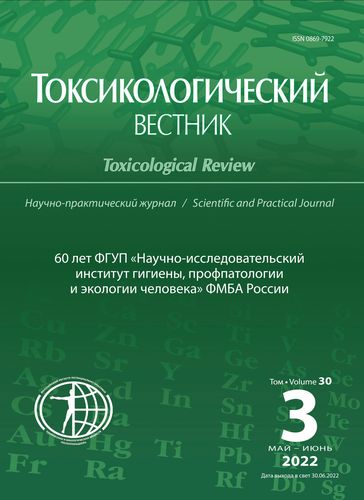Low-resolution GC-MS in metabolic profiling of biological samples with the mass spectrometry. Updating of the method
- Авторлар: Ukolov A.I.1
-
Мекемелер:
- Research Institute of Hygiene, Occupational Pathology and Human Ecology, FMBA
- Шығарылым: № 3 (2022)
- Беттер: 139-148
- Бөлім: Original articles
- ##submission.datePublished##: 20.06.2022
- URL: https://clinpractice.ru/0869-7922/article/view/641407
- DOI: https://doi.org/10.47470/0869-7922-2022-30-3-139-148
- ID: 641407
Дәйексөз келтіру
Толық мәтін
Аннотация
Introduction. The introduction of metabolomic approaches into the practice of toxicological studies, as well as the expansion of the methodological capabilities of the laboratory for the determination of low-molecular, metabolic biomarkers of the effect, makes it possible to more effectively detect and identify new biomarkers.
Material and methods. For metabolic profiling of blood plasma and urine samples, Shimadzu QP2010plus or Agilent 5975C gas chromatomass spectrometers were used. The results were processed using optimized databases of analytical characteristics of endogenous compounds and the AMDIS system; NIST/EPA/NIH 2017 was used to identify the detected compounds. Statistical processing was performed using Statistica.
Results. A two-stage procedure for preparing blood plasma and urine samples for analysis by GC-MS was developed, a mixture of internal standards was selected, a list of compounds — endogenous metabolites was determined, and the metrological characteristics of their determination were evaluated.
Limitations. The list of analytes suitable for determination by GC-MS is limited to volatile and conditionally volatile compounds.
Conclusion. Using an optimized database of sample metabolites prepared for analysis according to a standardized procedure allows filtering out analytes with low reproducibility. Small (up to 100) chromatospectral databases make it possible to increase the reliability of identification, eliminate the effect of retention time drift, and, as a result, increase the statistical power of the entire experiment without increasing the number of laboratory animals.
Негізгі сөздер
Авторлар туралы
Anton Ukolov
Research Institute of Hygiene, Occupational Pathology and Human Ecology, FMBA
Хат алмасуға жауапты Автор.
Email: ukolov.ai@gpech.ru
ORCID iD: 0000-0002-2911-1260
PhD, deputy head of toxicological department FSUE "Research Institute of Hygiene, Occupational Pathology and Human Ecology", FMBA of Russia, g.p. Kuzmolovskii, 188663, Leningrad region, Russian Federation.
e-mail: Ukolov.ai@gpech.ru
РесейӘдебиет тізімі
- Goncharov N.V., Ukolov A.I., Orlova T.I., Migalovskaya E.D., Voitenko N.G. Metabolomics: On the Way to an In-tegration of Biochemistry, Analytical Chemistry, and Informatics. Uspekhi sovremennoy biologii. 2015; 5(4): 296–307. (in Russian)
- Kusmierz J., DeGeorge J.D., Sweeney D., May C., Rapoport S.I. Quantitative analysis of polyols in human plasma and cerebrospinal fluid. J. Chromatogr. 1989; 497: 39–48.
- Michell R.H. Inositol and its derivatives: their evolution and functions. Adv. Enzyme Regul. 2011; 51(1): 84–90.
- Garcia-Bunuel L., Garcia–Bunuel V.M. Cerebrospinal fluid levels of free myo-inositol in some neurological disorders. Neurology. 1965 Apr; 15: 348-50. https://doi.org/10.1212/wnl.15.4.348
- Clement R. Diabetes Mellitus and Obesity. in B. Brodoff, S. Bleicher (Editors). Baltimore: Williams and Wilkins. 1982; 117.
- Smith S.L., Novotny M., Karmen A. Elevation of certain polyols in the cerebrospinal fluid of patients with multiple sclerosis. J. Chromatogr. 1984; 336: 351–5.
- Heimark D., McAllister J., Larner J. Decreased myo–inositol to chiro–inositol (M/C) ratios and increased M/C epimerase activity in PCOS theca cells demonstrate increased insulin sensitivity compared to controls. Endocr. J. 2014; 61(2): 111–7.
- Jung T.S., Hahm J.R., Kim J.J., Jung J.H., Kang M.Y., Moon S.W. et al. Determination of Urinary Myo–/Chiro–Inositol Ratios from Korean Diabetes Patients. Yonsei Med. J. 2005; 46(4): 532–8.
- Halket J.M., Waterman D., Przyborowska A.M., Patel R.K.P., Fraser P.D., Bramley P.M. Chemical derivatization and mass spectral libraries in metabolic profiling by GC/MS and LC/MS/MS. J. Exp. Bot. 2005; 56: 219–43.
- A J., Trygg J., Gullberg J., Johansson A.I., Jonsson P., Antti H. et al. Extraction and GC/MS analysis of the human blood plasma metabolome. Anal. Chem. 2005; 77: 8086–94.
- Blaise B.J. Data–Driven Sample Size Determination for Metabolic Phenotyping Studies. Anal. Chem. 2013; 85: 8943–50.
- Eng J. Sample size estimation: how many individuals should be studied? Radiology. 2003; 227(2): 309–13.
- Dell R.B., Holleran S., Ramakrishnan R. Sample Size Determination. Inst. Lab. Anim. Res. J. 2002; 43: 207–13.
- Vinaixa M., Samino S., Saez I., Duran J., Guinovart J.J., Yanes O. A Guideline to Univariate Statistical Analysis for LC/MS–Based Untargeted Metabolomics–Derived Data. Metabolites. 2012; 2: 775–95.
- Hendriks M.M.W.B., Eeuwijk F.A. van, Jellema R.H., Westerhuis J.A., Reijmers T.H., Hoefsloot H.C.J. et al. Data–processing strategies for metabolomics studies. Trends Anal. Chem. 2011; 30: 1685–98.
- Zenkevich I.G., Ukolov A.I., Kushakova A.S., Gustyleva L.K. Identification of isomeric alkylarenes with the use of additive relations for the evaluation of gas-chromatographic retention indices. Zhurnal Analiticheskoy Ximii. 2011; 66(12): 1165–72. (in Russian)
- Zenkevich I.G., Ukolov A.I. Coding of the structural features of organic compounds for the estimation of chromatographic retention indices with the use of additive schemes. Zhurnal Structurnoy Ximii. 2010; 51(4): 642–51. (in Russian)
- Ukolov A.I., Kessenikh E.D., Radilov A.S., Goncharov N.V. Toxicometabolomics: Identification of markers of chronic exposure to low doses of aliphatic hydrocarbons. Zhurnal e`volyucionnoy bioximii i fiziologii. 2017; 53(1): 25–36.
- Ukolov A.I., Shachneva M.D., Radilov A.S. identification of biomarkers of exposure and effect of 1,4-dichlorohexafluorobutene-2. Toksikologicheskii vestnik. 2019; 4(157): 23–31. (in Russian)
- Ukolov A.I., Radilov A.S. Metodologiya opredeleniya biomarkyorov organicheskih soedinenij s ispol’zovaniem hromatomass-spektrometrii. Medicina ekstremalnykh situacii. 2018; 20(3): 439–50. (in Russian)
Қосымша файлдар







